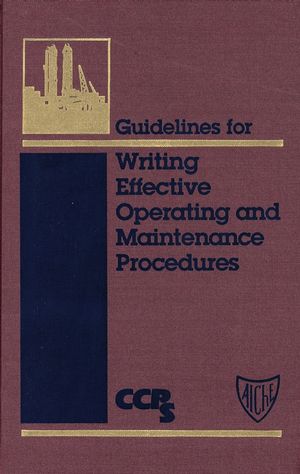Guidelines for Writing Effective Operating and Maintenance ProceduresISBN: 978-0-8169-0658-1
Hardcover
160 pages
May 1996
 This is a Print-on-Demand title. It will be printed specifically to fill your order. Please allow an additional 15-20 days delivery time. The book is not returnable.
|
||||||
Acknowledgments.
Glossary.
Chapter 1. Introduction to Effective Procedure Writing.
1.1. Why Was This Book Written?
1.2. Book Objectives.
1.3. The Current Worldwide Trend Toward Procedures.
1.4. Who Should Use This Book?
1.5. Where Do You Go From Here?
Chapter 2. Process Safety Environmental, and Quality Considerations.
2.1. Purpose.
2.2. Understanding the Guidelines and Regulations.
2.3. Voluntary Guidelines.
2.4. Governmental Regulations.
2.5. Quality Considerations.
2.6. Some Elements of Effective Procedures and Procedure.
Management Systems.
2.7. Additional Considerations.
2.8. Conclusion.
Endnotes.
Chapter 3. How to Design An Operating and Maintenance Procedure Management System.
3.1. Purpose.
3.2. The Importance of Written Procedures.
3.3. Elements of a Comprehensive Procedure Management System.
3.4. Determining Procedure Management System Requirements.
3.5. Evaluating Your Current Practices.
3.6. Identifying Your Resources.
3.7. Designing and Implementing Your Procedures Management System.
3.8. How to Determine Which Procedures to Write.
3.9. Implementing a Procedure Project.
3.10. Procedure Training.
3.11. Maintaining and Improving Your Procedure Management System.
3.12. Conclusion.
Chapter 4. Writing Operating and Maintenance Procedures.
4.1. Purpose.
4.2. What Resources Do You Need Before You Begin Writing?
4.3. What Do We Know About the Procedure.
4.4. Considerations for Effective Procedures.
4.5. Importance of Procedure Format.
4.6. Introductory Sections.
4.7. Procedure Steps Section.
4.8. Drafting the Procedure.
4.9. The Procedure Review and Approval Cycle.
4.10. Special Considerations for Maintenance Procedures.
4.11. Batch Process Considerations.
Chapter 5. Elements of Effective Procedures.
5.1. Purpose.
5.2. Importance of Procedure Evaluation Criteria.
5.3. Who Will Use the Procedure Evaluation Criteria?
5.4. Procedure Checklists Elements.
Endnotes.
Chapter 6. Writing Emergency Operating Procedures.
6.1. Purpose.
6.2. Defining Events Requiring Emergency Operating Procedures.
6.3. Identifying Emergency Situations.
6.4. Developing and Writing Emergency Operating Procedures.
6.5. Directing the User to the Correct Emergency Operating Procedure.
6.6. Incorporating Human Factors in Emergency Operating Procedures.
6.7. using Decision Aids.
6.8. How Emergency Operating Procedures Link to the Emergency Response Plan.
Endnotes.
Chapter 7. Procedure Control.
7.1. Purpose.
7.2. What Is Procedure Control?
7.3. Controlling Procedure Revisions and Development.
7.4. Who Should Review the Procedures?
7.5. Procedure Approval.
7.6. Evaluating Procedures In Use.
7.7. Electronic Document Control.
Chapter 8. Procedure Development Costs and Benefits.
8.1. Purpose.
8.2. reasons for Procedure Development.
8.3. Procedure Development Costs.
8.4. Return on Investment: Improvements You Can Expect from Effective Procedures.
Endnotes.
Appendix A. Selected Procedure Initiatives, Consensus Codes, and Regulations Affecting Procedures.
Appendix B. Common Points of API, OSHA, and EPA.
Appendix C. How to Determine the Tasks That Require Written Procedures.
Appendix D. Procedure Performance Evaluation.
Appendix E. Procedure Criteria Checklist.
Appendix F. Sample Procedure Formats.
Appendix G. Sample Formats of Operating Limits Tables.
General References.
Index.



